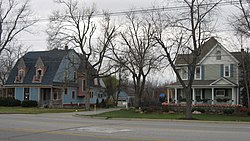
The Starr Historic District is a neighborhood of historic buildings and national historic district located at Richmond, Wayne County, Indiana. The district encompasses 102 contributing buildings in a predominantly residential section of Richmond. It developed between about 1853 and 1915 and includes representative examples of Greek Revival, Italianate, Second Empire, and Queen Anne style architecture. Included in the district is a former Hicksite Quaker Meeting House, now the Wayne County Historical Museum and the Reid Memorial Presbyterian Church and Andrew F. Scott House. Other notable buildings include the Miller-Mendenhall House (1875), Dickinson Log House (1825), Starr-Cadwalader House (1861), and Clem Gaar House (1883).

Upper Main Street Historic District is a national historic district located at Lafayette, Tippecanoe County, Indiana. Sixth Street was the City of Lafayette's eastern boundary when it was originally platted. By 1840, the boundary was extended to include Lake Erie and Wabash Railroad at Eleventh Street. This area became the cities commercial center. Businesses around Eleventh Street developed to meet the traveling publics needs. The Enterprise Hotel, at 1015 Main Street, as well as the Alt Heidelberg, American Lafayette and the Derby Hotel were early established by 1899.

Oakdale Historic District is a national historic district located at Fort Wayne, Indiana. The district encompasses 334 contributing buildings and 38 contributing objects in a predominantly residential section of Fort Wayne. The area was developed between about 1915 and 1930, and includes notable examples of Colonial Revival, American Four Square, and Bungalow / American Craftsman style residential architecture. The contributing objects are entry markers and streetlamps.

Lafayette Place Historic District is a national historic district located at Fort Wayne, Indiana. The district encompasses 582 contributing buildings, 1 contributing site, 1 contributing structure, and 1 contributing object in a predominantly residential section of Fort Wayne. The area was developed from about 1915 to 1963, and includes notable examples of Colonial Revival, Tudor Revival, and Bungalow / American Craftsman style residential architecture. The neighborhood was platted and designed by noted landscape architect Arthur Asahel Shurcliff.

Columbus Historic District is a national historic district located at Columbus, Bartholomew County, Indiana. It encompasses 574 contributing buildings and 1 contributing sites in the central business district and surrounding residential areas of Columbus. It was developed between about 1850 and 1930, and includes notable examples of Federal and Italianate style architecture. A number of commercial buildings feature locally manufactured cast iron and pressed metal components. Located in the district are the separately listed Bartholomew County Courthouse, Columbus City Hall, and First Christian Church. Other notable buildings include the First National Bank, The Crump Theatre (1889), Reo Theater, Ulrich Bakery, Samuel Harris House (1853), Keller House (1860), Old Post Office (1910), Franklin Building, Gent Mill, First United Presbyterian Church (1871-1885), Irwin Block, Irwin Home and Gardens, and St. Batholomew's Roman Catholic Church (1891).
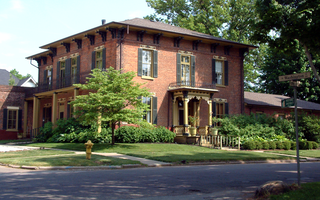
Brady Street Historic District is a national historic district in Attica, Fountain County, Indiana. The district encompasses 108 contributing buildings, 9 contributing structures, and 4 contributing objects in a predominantly residential section of Attica. It developed between about 1840 and 1930, and includes notable examples of Greek Revival, Gothic Revival, and Italian Villa style architecture. Notable contributing buildings include the Carnegie library (1904), Schlosser House (1840s), Catholic Church (1891) and rectory (1895), McClaflin House (1904), and Greenwood House (1877).

Marion Downtown Commercial Historic District is a national historic district located at Marion, Grant County, Indiana. It encompasses 52 contributing buildings, 2 contributing structures, and 1 contributing object in the central business district of Marion. It developed between about 1870 and 1942, and includes notable examples of Italianate, Romanesque, and Classical Revival style architecture. Located in the district is the separately listed Grant County Jail and Sheriff's Residence. Other notable buildings are the Grant County Courthouse (1881-1883), Marion Bank Building, Iroquois Building, Dan-Mar Apartments, United Telephone Block, Cecelian Apartments, Marion Post Office, and William Smith Building / Mecca Club.

Danville Main Street Historic District is a national historic district located at Danville, Hendricks County, Indiana. The district encompasses 42 contributing buildings and 2 contributing structures in the central business district of Danville. The district developed between about 1865 and 1960 and includes notable examples of Italianate, Classical Revival, Beaux-Arts, and Tudor Revival style architecture. Located in the district is the separately liste Hendricks County Jail and Sheriff's Residence. Other notable buildings include the Hall Block, Danville Public Library (1902-1903), Hendricks County Courthouse (1915), and Danville Post Office (1936).

Plymouth Southside Historic District is a national historic district located at Plymouth, Marshall County, Indiana. The district encompasses 91 contributing buildings, 2 contributing structures, and 1 contributing object in a predominantly residential section of Plymouth. It developed between about 1853 and 1953, and includes examples of Italianate, Greek Revival, Queen Anne, Colonial Revival, and Tudor Revival style architecture. Notable contributing resources include the John McFarlin, Jr., House, Trinity United Methodist Church (1926), Bible Baptist Church (1894), Felke Florist and Greenhouse (1922), John Soice Residence, Westervelt-Marble Residence, and Edwards-Gambel Residence (1856).

Martinsville Commercial Historic District is a national historic district located at Martinsville, Morgan County, Indiana. The district encompasses 75 contributing buildings and 1 contributing object in the central business district of Martinsville. It developed between about 1847 and 1947, and includes notable examples of Italianate, Classical Revival, and Tudor Revival style architecture. Located in the district are the separately listed Morgan County Courthouse and Blackstone House and Martinsville Telephone Company Building. Other notable buildings are the Martinsville Public Library, Martinsville City Hall (1917), Martinsville Post Office, Pitkin Building, Barskin's Department Store (1922), Indiana Theater, Steven's House / Building, Hale Building, Interurban Station, Union Block (1866), and First Christian Church (1891) and Annex (1927).

Ligonier Historic District is a national historic district located at Ligonier, Noble County, Indiana. The district encompasses 253 contributing buildings and 2 contributing objects in Ligonier. It developed between about 1835 and 1937, and includes notable examples of Italianate, Queen Anne, Gothic Revival, Classical Revival, and Bungalow / American Craftsman style architecture. Located in the district are the separately listed Ahavas Shalom Reform Temple and Jacob Straus House. Other notable buildings include the Dr. Enos Fenton Residence, Silas Shobe Residence, Eli Gerber Residence (1874), Oscar Parks Residence (1892), Solomon Mier Residence (1906), Simon Schloss Residence (1912), Gentry Hotel (1870), Straus Brothers Block (1888), Zimmerman Block, former Universalist Church (1856), First Presbyterian Church (1890), Ligonier Public Library (1908), Ligonier City Building (1914), U.S. Post Office (1935), Lyon and Greenleaf Flour Mill (1886), and former Mier Carriage Factory (1891).

Highland Park Neighborhood Historic District is a national historic district located at Lafayette, Tippecanoe County, Indiana. The district encompasses 240 contributing buildings, 1 contributing site, and 1 contributing structure in a planned residential subdivision of Lafayette. It developed between about 1892 and 1945 and includes representative examples of Queen Anne, Tudor Revival, and Bungalow / American Craftsman style architecture. Notable contributing resources include the Blistain Axel Merritt House (1914), John Wagner Jr. House, John Ross House, and Bicycle Bridge (1924).

Ninth Street Hill Neighborhood Historic District is a national historic district located at Lafayette, Tippecanoe County, Indiana. The district encompasses 88 contributing buildings and 6 contributing structures in a predominantly residential section of Lafayette. It developed between about 1850 and 1946 and includes representative examples of Gothic Revival, Italianate, Queen Anne, Greek Revival, and Second Empire style architecture. Located in the district is the separately listed Judge Cyrus Ball House. Other notable contributing resources include the Samuel Moore House (1891), Moore-Porter-Boswell House (1895), Stanley Coulter House (1890), Edward Bohrer House (1909), Thomas Wood House, Job M. Nash House (1859), and Gordon Graham House.
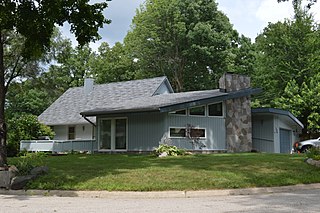
Happy Hollow Heights Historic District is a national historic district located at West Lafayette, Tippecanoe County, Indiana. The district encompasses 54 contributing buildings in a predominantly planned residential section of Lafayette, platted in 1953 and expanded in 1958. It developed between about 1953 and 1967 and includes representative examples of Ranch, Modern, and Split-level style architecture.

Liberty Residential Historic District is a national historic district located at Liberty, Union County, Indiana. The district encompasses 67 contributing buildings in a predominantly residential section of Liberty. It developed between about 1841 and 1920 and includes representative examples of Greek Revival, Italianate, Queen Anne, Colonial Revival, Bungalow / American Craftsman, and Ranch style architecture. Notable contributing buildings include the First Presbyterian Church (1889), Union County Public (Carnegie) Library (1915), John S. Nixon House (1879), John B. Macy House (1876), and Union County Seminary (1841).

Clinton Downtown Historic District is a national historic district located at Clinton, Vermillion County, Indiana. The district encompasses 46 contributing buildings, 1 contributing site, and 1 contributing object in the central business district of Clinton. It developed between about 1880 and 1935 and includes representative examples of Italianate, Romanesque Revival, and Bungalow / American Craftsman style architecture. Notable contributing resources include the C. & E. I Passenger Station, Bogart Park and Claude Matthews bust / memorial, Scott-Martin Block (1907), H.H. Wisehart Building (1915), Mark W. Lyday Building, Ford Agency Building, and C. & E. I Freight Depot (1912).
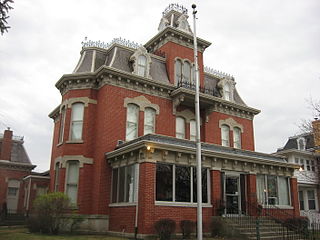
Stewart-Studebaker House, also known as the John Studebaker Residence, is a historic home located at Bluffton, Wells County, Indiana. It was built in 1882, and is a two-story, Second Empire style red brick dwelling topped by a slate mansard roof. It features a Mansarded tower above the main entrance.

John A. Grove House, also known as the Henry H. Hunsicker Residence, was a historic home located at Bluffton, Wells County, Indiana. It was built in 1891, and was a two-story, Queen Anne style frame dwelling. It featured a conical-roofed turret, steeply pitched hipped roof, and arcaded front porch.
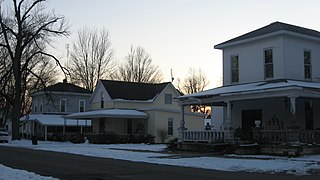
Roann Historic District is a national historic district located at Roann and Paw Paw Township, Wabash County, Indiana. It encompasses 117 contributing buildings, 2 contributing sites, and 1 contributing structure in the central business district and surrounding residential sections of Roann. It developed between about 1853 and 1961, and includes representative examples of Gothic Revival, Italianate, Queen Anne, Second Empire, Colonial Revival, and Streamline Moderne style architecture. Located in the district are the separately listed Roann Covered Bridge, Roann-Paw Paw Township Public Library, and Thomas J. Lewis House. Other notable buildings include the First Brethren Church (1891), Dersham House and Veterinary Clinic, Roann Christian Church (1961), Watson House, Universalist Church (1875), Roann Methodist Church (1898), Paw Paw Township School (1941), James Van Buskirk House, Halderman Building, U.S. Post Office and Medical Building (1958), Nicely Oil Service Station (1938), Comer Building (1920), and Spiece House.

North Meridian Street Historic District is a national historic district located at Indianapolis, Indiana. It encompasses 169 contributing buildings in a high style residential section of Indianapolis. The district developed between about 1900 and 1936, and includes representative examples of Tudor Revival, Colonial Revival, and Classical Revival style architecture. Located in the district is the separately listed William N. Thompson House. Other notable contributing resources include the Evan-Blankenbaker House (1901), Sears-Townsend House (1930), MacGill-Wemmer House, Hugh Love House (1930), Hare-Tarkington House (1911), Shea House (1922), and Brant-Weinhardt House (1932).
